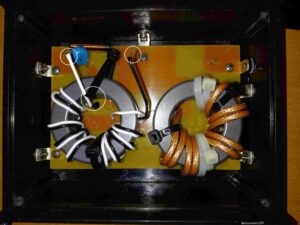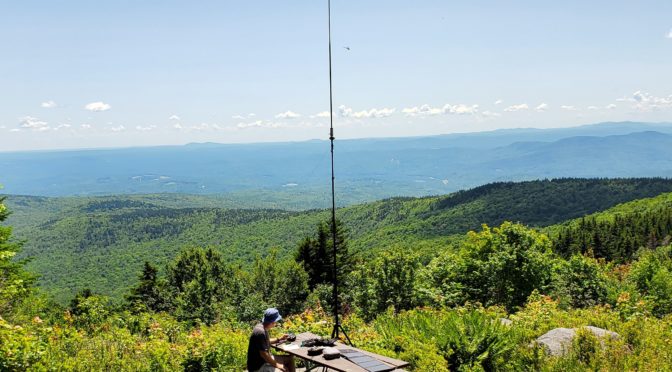With the exception of a 2m handheld and a temporary end-fed half-wave vertical[1] for use on 20m in the IARU CW contest, I have been off the air since July 2020. After assessing the rocky soil in the backyard, I have come to the conclusion that ground radials won’t be gobbled up by the lawn as they were by the St. Augustine Grass in Florida[2]. That’s when I decided to install a compromise antenna – one that does not require radials. Since I am apt to hang half-wave antennas for the top bands, I settled on the Hy-Gain AV-640[3].
The AV-640 is an 8-band antenna that, in addition to the WARC bands, adds 6m. Since I have not operated on the “magic band” for many years, it’s a nice bonus.
The AV-640 arrived from the supplier in a box that was intact, but the first thing on the to-do list was to complete a parts inventory. That task was completed in, maybe, two hours. During that time, the parts, particularly small hardware, were separated into several Ziploc bags for easy identification later.
It turned out that there were a few pieces of stainless hardware and mounting brackets missing, and MFJ, with help from DX Engineering[4], replaced them in record time. Encouraged by the quick replacements, I decided to perform one last check before installing the antenna. Like any good homebrew tinkerer, I decided to open the Matching Network, Figure 1, to see what was inside and to make certain that nothing was broken. My curiosity was rewarded. I found that two wires had broken, thereby, separating them from the printed circuit board. There was also a Ty-Rap normally looped through the circuit board to anchor the toroid cores that had snapped. MFJ gave me the choice of repairing the unit myself which would have required complete disassembly, or a replacement assembly. I chose the latter.

Figure 1. Interior View of the Hy-Gain AV-640 Matching Unit. Please click on the image to enlarge it. A 1:1 current UNUN (right) for common mode rejection is followed by a 9T:20T autotransformer (left) for a turns ratio of 1:2.22. The black and white wires are connected in series. The black wire is the so-called “common winding”, while the white wire is the so-called “series winding”. The circuit board traces can be seen from the top. The matching unit arrived damaged with a black and a white wire detached from the PCB. The points of damage are circled in white. The broken black wire should be soldered to the PCB within the toroid. A Ty-Rap had also snapped. The 1:1 current UNUN is visible to the right.
Under “Theory of Operation” the AV-640 manual describes[5] the matching unit as a “broadband RF transformer” in one sentence and later on as a “4:1 toroidal transformer (voltage balun)”. Since the copper on the backside of the PCB is visible from the top, the wiring could be traced without removing the circuit card from the housing. What I saw was something that was a 1:1 stacked-core current UNUN[6] for common mode rejection followed by a stacked-core autotransformer having a 9:20 turns ratio (in Figure 1, the broken black wire should loop through the toroid and be soldered to the PCB within the core I.D.)
The schematic of the matching unit is shown in Figure 2. The autotransformer has a 9-turn (common) primary and a 11-turn (series) secondary. The black primary (common) winding of 9-turns is in series with the white 11-turn (series) secondary winding to form a 9:20 turn autotransformer. The voltage turns ratio is 1:2.22, whereas, the impedance transformation ratio goes as N2, or 1:4.93. So, the autotransformer transforms 50 ohms to 247 ohms. A shortened radial ground plane, lowers the impedance at the antenna base.

Figure 2. Hy-Gain AV-640 Matching Unit Schematic Diagram. Please click on the figure to enlarge it. A 1:1 current UNUN is followed by an autotransformer. Note that the left end of the UNUN is dotted. The coax shield is wound with the same sense as the center conductor to form a common mode choke. An autotransformer that follows transforms the impedance from 50 ohms to 247-ohms. Note that the left end of the autotransformer is dotted. The black and white windings are wound with the same sense. Point D is connected to point A to place the primary (common) winding in series with the secondary (series) winding. The antenna is placed at DC ground potential by an RF choke that serves to bleed static charge from the antenna. The autotransformer is AC-coupled to the antenna by a high voltage ceramic capacitor. The short (72″ long) ground plane radials, depicted, lower the impedance at the antenna feed point to one that is more easily accommodated by the autotransformer. Please note that the ground return for the autotransformer and ground plane radial combination is brought back to the input connector via the common mode choke coax shield that is wound around the ferrite core. The 247-ohm impedance match at the antenna feed point is a compromise match for the 8 bands. As a practical consideration, a remote antenna tuner should be located as close to the matching unit as is practical to remove standing waves from the transmission line.
We might also take a look at the voltages at the secondary of the autotransformer to see if they are reasonable. At 100W we expect to see 70.7 Vrms (100 Vpeak) under matched conditions at the current UNUN input. If we multiply this by the 1:2.22 voltage turns ratio, we have 157 Vrms (222 Vpeak) at the antenna terminal. These numbers increase somewhat for 1.5 kW to 274 Vrms (387 Vpeak) and 608 Vrms (860 Vpeak), respectively.
It has been shown previously[7] that these numbers may degrade by as much as the square root of the VSWR. Thus, for a VSWR of 3:1, we might expect these numbers to increase by a factor of 1.732, and so on.
The lossy ferrite used in the UNUN and in the autotransformer places limits on the continuous (key-down) operation of this antenna. This subject was discussed in other posts[8][9].
For these reasons, this antenna has been rated for operation on each band within their 2:1 VSWR bandwidths[10].
References
[1] Blustine, Martin, Temporary 20m EFHW Vertical Installation, N1FD post, July 2, 2023. https://www.n1fd.org/2023/07/02/20m-efhw-vertical/
[2] Blustine, Martin, A Flagpole Antenna Project for Residential Settings, N1FD post, May 23, 2022. https://www.n1fd.org/2022/05/23/flagpole-antenna/
[3] Hy-Gain AV-640, HF VERTICAL, 8 BANDS-40/30/20/17/15/12/10/6 M, MFJ Enterprises, Inc., 308 Industrial Park Rd, Starkville, MS 39759. https://mfjenterprises.com/products/av-640
[4] DX Engineering, 1200 Southeast Ave.Tallmadge, Ohio 44278. https://www.dxengineering.com/parts/hgn-av-640
[5] Hy-Gain AV-640 8-Band Vertical Antenna, Instruction & Assembly Manual, Revised 14 July 2023, pp. 3-4. Hy-Gain, 308 Industrial Park Road, Starkville, Mississippi 39759. https://static.dxengineering.com/global/images/instructions/hgn-av-640_co.pdf?_gl=1*em8g2o*_ga*Nzc2NjgwNDEyLjE2OTQxMTU0MjQ.*_ga_NZB590FMHY*MTY5NDExNTQyNC4xLjEuMTY5NDExNTg0MS41MC4wLjA.
[6] Blustine, Martin, Differential and Common Modes on Transmission Lines – Part II, N1FD post, September 14, 2022. https://www.n1fd.org/2022/09/14/differential-and-common-modes-on-transmission-lines-part-ii/
[7] Blustine, Martin, Worst Case Standing Wave Voltage on a Transmission Line, N1FD post, August 1, 2022. https://www.n1fd.org/2022/08/01/standing-wave-voltage/
[8] Blustine, Martin, Power Losses and Dissipation in Various Ferrite Devices – Part I, N1FD post, August 10, 2022. https://www.n1fd.org/2022/08/10/ferrite-device-losses/
[9] Blustine, Martin, Power Losses and Dissipation in Various Ferrite Devices – Part II, N1FD post, August 12, 2022. https://www.n1fd.org/2022/08/12/ferrite-loss-2/
[10] Hy-Gain AV-640 8-Band Vertical Antenna, Instruction & Assembly Manual, Op. Cit., p. 5. https://static.dxengineering.com/global/images/instructions/hgn-av-640_co.pdf?_gl=1*em8g2o*_ga*Nzc2NjgwNDEyLjE2OTQxMTU0MjQ.*_ga_NZB590FMHY*MTY5NDExNTQyNC4xLjEuMTY5NDExNTg0MS41MC4wLjA.





